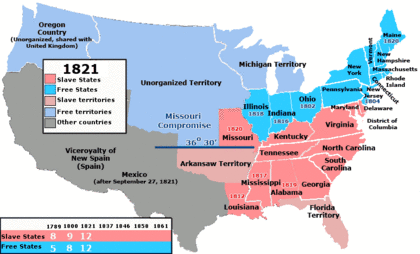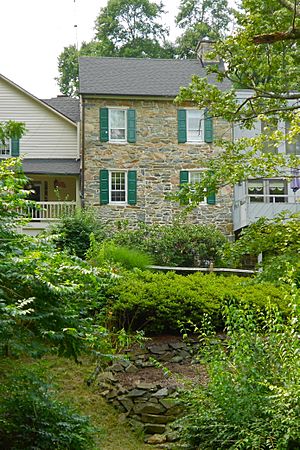Margaret Morgan (slave) facts for kids
Margaret Morgan (born between 1800 and 1805) was an African American woman. Her parents were once enslaved but were considered free by their owner. However, they never received official papers called a deed of manumission to prove their freedom. They continued to live on their former owner's land, where Margaret was born.
After Margaret grew up, got married, and had children, her family was taken from their home in the middle of the night. This happened around March 1837. The widow of the former slave owner, Margaret Ashmore, had asked for them to be taken.
Margaret Morgan's case became very important. It led to legal battles at local, state, and even national levels from 1837 to 1842. The most famous case was Prigg v. Pennsylvania, which went all the way to the U.S. Supreme Court. The four men who captured Margaret and her children were found not guilty.
This court decision made it easier for slave owners to capture people they claimed were their slaves, even in free states. It also made it hard for Pennsylvania to use its 1826 personal liberty law, which was meant to protect its citizens from being enslaved. The decision also helped lead to the Fugitive Slave Act of 1850. This law made it even easier for slave catchers to take Black people from free states.
From a legal point of view, the main question was whether states could make laws to protect their citizens' freedom. Sadly, the court case did not focus on Margaret Morgan and her children as human beings who deserved protection. What happened to Margaret and her children after the case is not fully known.
Contents
Margaret Morgan's Early Life and Family
Margaret, also known as "Peg," was born between 1800 and 1805. She was born in the Dublin area of Harford County, Maryland. This was near Prospect Road in the Mill Green area. Her parents were older and had been owned by a man named John Ashmore.
John Ashmore said her parents were free after the War of 1812. But he never gave them the official papers called a deed of manumission. This meant they might not have met Maryland's rules for freeing enslaved people. For example, Maryland law said enslaved people could not be freed if they were over 45, had a serious health problem, or if freeing them would harm the owner's debts.
In 1820, Ashmore owned ten enslaved people. He freed six or more before he died in 1823. In 1824, only two enslaved boys were listed in his estate records. Margaret Morgan and her parents were not on this list. This suggests they were considered free by then.
Margaret and her parents lived on a piece of land on the Ashmore property. She lived freely and did not have to work for the Ashmore family.
In 1828, Margaret married Jerry Morgan, who was born free in Pennsylvania. In 1830, a census taker wrote that Margaret was a free Black woman. They also had two free Black children. After her parents died in 1832, the Morgans moved from Maryland to Pennsylvania. This move took them across the Mason–Dixon line into a free state. They settled about seven or eight miles away in Airville, York County. Jerry Morgan worked for Matthew Wallace. By 1837, Margaret and Jerry had at least four children.
John Ashmore knew Margaret was living in a free state. Yet, he never tried to get her or her children back. There were no "runaway" ads for her in newspapers. Since slavery was illegal in Pennsylvania, it seemed Margaret and her children could live freely. Some historians believe Margaret and some of her children were truly free by 1837.
Laws About Slavery and Freedom

Pennsylvania was the first state to pass a law against slavery in 1780. This law, called An Act for the Gradual Abolition of Slavery, said that if slave owners brought enslaved people into the state, those people would become free after six months.
In response to the national Fugitive Slave Act of 1793, Pennsylvania passed its own personal liberty law in 1826. This law made it illegal to take anyone out of Pennsylvania to be enslaved. It also said that to take a person out of the state as a slave, a special paper called a warrant was needed. This warrant had to come from a judge or justice of the peace. If an enslaved person came to Pennsylvania and had a child after living there for a year or more, that child would be considered a native of Pennsylvania and free.
Pennsylvania and other Northern states tried to tell the difference between real claims by slave owners and false claims. False claims were often made by slave catchers who kidnapped free Black people for money. People thought that if a claim was real, the slave owner would follow the legal process. But if it was false, the kidnapper would not. Still, people in the South were unhappy. They felt these laws went against their rights.
In 1831, Nat Turner's slave rebellion happened. This was a revolt by free and enslaved African Americans. It caused a lot of fear among white people, leading them to try and limit the rights of African Americans.
Another important factor was that the economy had changed. Keeping enslaved people in Maryland was not as profitable as it was in the cotton-growing states in the South. In the ten years before Margaret's capture, the number of enslaved people in Maryland dropped by 10%. The number of free Black people increased by 50%. Enslaved people feared that with less demand in Maryland, they might be sold to Southern states like Mississippi and Alabama. There, the demand for enslaved people was high, and prices were higher. The work on cotton and sugar plantations in the Deep South was much harder than in Maryland. Because of this fear, many enslaved Black people escaped into and through Pennsylvania.
Margaret Morgan's Capture
John Ashmore's wife, Margaret Ashmore, inherited part of her husband's property. In 1837, she decided that Margaret Morgan and her children should be brought to Maryland to live and work as enslaved people. The farm went to Ashmore's daughter, Susanna, and her husband, Nathan Bemis. Margaret Ashmore continued to live there after her husband's death. She hired Edward Prigg and Nathan Bemis to find the Morgans. Nathan Bemis found where the Morgans lived.
Prigg, Bemis, and two other men planned to capture Margaret Morgan. They followed Pennsylvania's personal liberty law by contacting a justice of the peace, Thomas Henderson. He issued a warrant for Margaret and her children's arrest. The men were told to contact William McCleary, the constable of York County. McCleary went with them to capture the Morgans.
McCleary and the slave hunters went to the Morgan's house in late March 1837. The family was asleep. They captured the entire family in their nightclothes. They were taken "with force and violence" in "an open wagon in a cold sleety rain, with scarcely their ordinary clothes on."
After facing local activists, the capturers tried to get a certificate from Henderson to take the Morgans to Maryland. Henderson released Jerry Morgan because he was born free. He would not allow Margaret and her children to be taken to Maryland. He believed Margaret and her children were free under state law. He refused to be involved further because the Morgans and Prigg's group told different stories.
The capturers could not find a judge who would give them the certificate. So, Prigg, Bemis, and the others waited until Jerry had left his house. They then took Margaret and her children a second time. They were put in a jail in Bel Air, Maryland. A county judge, Stevenson Archer, approved their sale. They may have been sold to a slave trader soon after they arrived in Maryland. People tried to free Margaret and her children, but she might have been taken away before their request could be heard. The governors of Pennsylvania, Joseph Ritner, and Maryland, Thomas W. Veazey, were told about the case. Governor Ritner was strongly against slavery.

Jerry traveled to the state capital many times to ask Governor Ritner for help to free his family. On his last trip, he took a boat to go home to Columbia, Pennsylvania. During the trip, Jerry, who was the only Black person on the boat, was accused of stealing a man's coat. After his hands were tied and he was threatened, he jumped off the boat into the Susquehanna and Tidewater Canal and the Susquehanna River. He drowned in the strong current.
The Supreme Court Case
When the case was first tried, the prosecutor in York County, Thomas Hably, said that Justice Henderson was hesitant to get involved. This was because Henderson realized the capture was against Pennsylvania's 1826 personal liberty law. Hably may have tried to get the Morgans returned to Pennsylvania, but he was not successful.
A grand jury in Pennsylvania charged Prigg and the other men with breaking the Personal Liberty Law of 1826. They were found guilty of kidnapping. However, officials in Maryland would not release the Morgans. Prigg argued that it was against the U.S. Constitution to stop slave owners from getting back people they considered runaway slaves. He believed Margaret Morgan was a runaway slave.
In October 1837, a local court ruled in favor of Margaret Ashmore. In 1839, a trial was held in Pennsylvania. Prigg was the only one tried, and he was found guilty of kidnapping. The Prigg v. Pennsylvania case was then appealed all the way to the U.S. Supreme Court in 1842. The Supreme Court decided in favor of Prigg.
The Court ruled that state law should not be stronger than federal law. They said that Article IV of the U.S. Constitution allowed for the return of runaway slaves. They also said that Pennsylvania's state law went against the Fugitive Slave Act of 1793.
The arguments in the case did not focus on whether Margaret Morgan and her children were people who deserved to be free.
The Supreme Court's decision made it easier for slave owners to capture people in free states. It also made it harder for states to use their personal liberty laws. Some states then passed laws that stopped their officials from helping to carry out the Fugitive Slave Act of 1793. This led to the national Fugitive Slave Act of 1850. This new law made it even easier to catch runaway slaves. It also made it illegal and more dangerous for people, like those who helped on the Underground Railroad, to assist enslaved people escaping to freedom.
What happened to Margaret Morgan and her children is not clear. Some records show that Margaret and her children were sold to a slave owner in the South. Other records suggest that Margaret and her children lived in Cecil County, Maryland until about 1870. It's believed that those sold to the South might have returned to Maryland at some point. After that, they may have gone further south or west, or been sold to another slave owner. Margaret may have had a son who escaped from his slave owner in Maryland. On June 8, 1857, a newspaper ad offered $500 for the return of 21-year-old Edward Morgan, a runaway. However, the Maryland State Archives says there are no known records of the family being sold. There is also no evidence that the Ashmores lived in Harford County after 1830.


